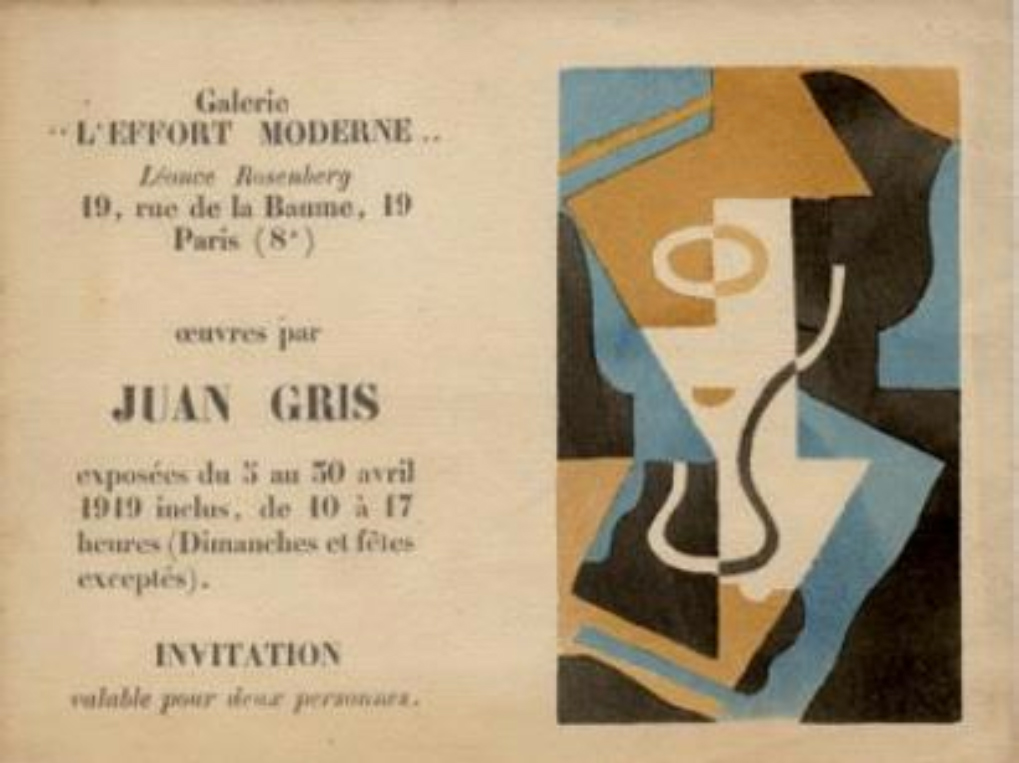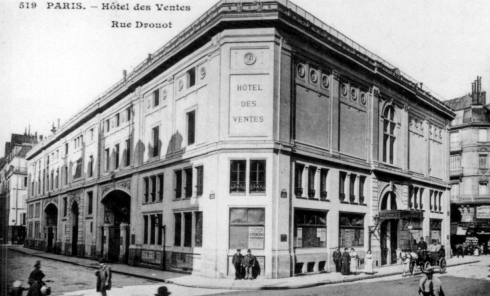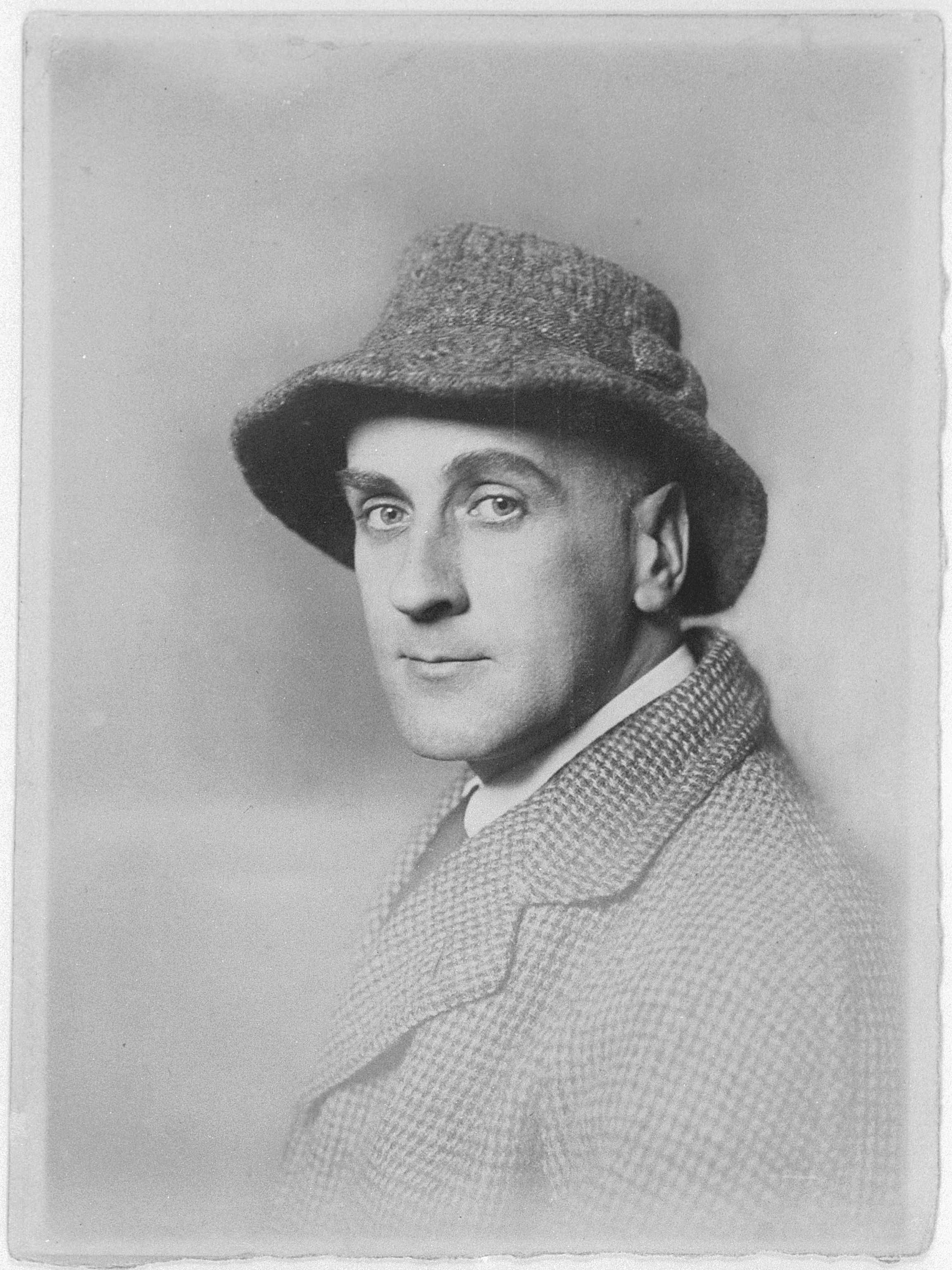|
Léonce Rosenberg
Léonce Rosenberg (12 September 1879 in Paris – 31 July 1947 in Neuilly-sur-Seine) was an art collector, writer, publisher, and one of the most influential French art dealers of the 20th century. His greatest impact was as a supporter and promoter of the cubists, especially during World War I and in the years immediately after. Early life The son of an antique dealer Alexandre Rosenberg and brother of the gallery owner Paul Rosenberg (art dealer), Paul Rosenberg (21 rue de la Boétie, Paris), Léonce Rosenberg attended the Lycée Rollin in Paris followed by commercial training in Antwerp and London as well as travels to Berlin, Vienna and New York. Léonce Rosenberg took the opportunity to visit galleries and museums to broaden his artistic knowledge and appreciation, and to develop contacts in the art world. After returning to Paris he worked with his brother Paul in the family business. In 1906 Léonce and his brother took over the running of the family gallery, then on Avenu ... [...More Info...] [...Related Items...] OR: [Wikipedia] [Google] [Baidu] |
Jean Metzinger, 1924, Portrait De Léonce Rosenberg, Pencil On Paper, 50 X 36
Jean may refer to: People * Jean (female given name) * Jean (male given name) * Jean (surname) Fictional characters * Jean Grey, a Marvel Comics character * Jean Valjean, fictional character in novel ''Les Misérables'' and its adaptations * Jean Pierre Polnareff, a fictional character from ''JoJo's Bizarre Adventure'' Places * Jean, Nevada, USA; a town * Jean, Oregon, USA Entertainment * Jean (dog), a female collie in silent films * "Jean" (song) (1969), by Rod McKuen, also recorded by Oliver * ''Jean Seberg'' (musical), a 1983 musical by Marvin Hamlisch Other uses * JEAN (programming language) * USS ''Jean'' (ID-1308), American cargo ship c. 1918 * Sternwheeler Jean, a 1938 paddleboat of the Willamette River See also *Jehan * * Gene (other) * Jeanne (other) * Jehanne (other) * Jeans (other) * John (other) John is a common English name and surname: * John (given name) * John (surname) John may also refer to: New Testa ... [...More Info...] [...Related Items...] OR: [Wikipedia] [Google] [Baidu] |
Jacques Lipchitz
Jacques Lipchitz (26 May 1973) was a Cubist sculptor. Lipchitz retained highly figurative and legible components in his work leading up to 1915–16, after which naturalist and descriptive elements were muted, dominated by a synthetic style of Crystal Cubism. In 1920 Lipchitz held his first solo exhibition, at Léonce Rosenberg's Galerie L'Effort Moderne in Paris. Fleeing the Nazis he moved to the US and settled in New York City and eventually Hastings-on-Hudson. Life and career Jacques Lipchitz was born Chaim Jacob Lipschitz, in a Litvak family, son of a building contractor in Druskininkai, Lithuania, then within the Russian Empire. He studied at Vilnius grammar school and Vilnius Art School. Under the influence of his father he studied engineering in 1906–1909, but soon after, supported by his mother he moved to Paris (1909) to study at the École des Beaux-Arts and the Académie Julian. It was there, in the artistic communities of Montmartre and Montparnasse, that he jo ... [...More Info...] [...Related Items...] OR: [Wikipedia] [Google] [Baidu] |
Christopher Green (art Historian)
Christopher Kenneth Green, (born in 1943) is a British art historian, who was professor of the History of Art at the Courtauld Institute of Art between 1991 and 2008. Early life Christopher Kenneth Green was born in 1943,"Green, Prof. Christopher Kenneth" ''Who's Who 2017'', A & C Black (online edn, Oxford University Press, November 2016). Retrieved 7 November 2017. the second son of Frederic Ray Hilton Green, a civil servant with the who served as Inspector of Mines in and later lived at |
Louis Vauxcelles
Louis Vauxcelles (born Louis Meyer; 1 January 187021 July 1943) was a French art critic. He is credited with coining the terms '' Fauvism'' (1905) and ''Cubism'' (1908). He used several pseudonyms in various publications: Pinturrichio, Vasari, Coriolès, and Critias. Fauvism Vauxcelles was born in Paris. He coined the phrase 'les fauves' (translated as 'wild beasts') in a 1905 review of the Salon d'Automne exhibition to describe in a mocking, critical manner a circle of painters associated with Henri Matisse. As their paintings were exposed in the same room as a Donatello sculpture of which he approved, he stated his criticism and disapproval of their works by describing the sculpture as "a Donatello amongst the wild beasts." Henri Matisse's '' Blue Nude (Souvenir de Biskra)'' appeared at the 1907 Indépendants, entitled ''Tableau no. III''. Vauxcelles writes on the topic of ''Nu bleu'': I admit to not understanding. An ugly nude woman is stretched out upon grass of an opaque ... [...More Info...] [...Related Items...] OR: [Wikipedia] [Google] [Baidu] |
André Salmon
André Salmon (4 October 1881, Paris – 12 March 1969, Sanary-sur-Mer) was a French poet, art critic and writer. He was one of the early defenders of Cubism, with Guillaume Apollinaire and Maurice Raynal. Biography André Salmon was born in Paris, in the XI arrondissement, the fourth child of Émile-Frédéric Salmon, a sculptor and etcher, and Sophie-Julie Cattiaux, daughter of a founder of the Radical Socialist Party. Often assumed to come from a Jewish family,Peter Y. Medding, ''Studies in Contemporary Jewry: Volume XIV: Coping with Life and Death: Jewish Families in the Twentieth Century'', Oxford University Press (1999), p. 313 they were in fact secular Republicans, frequently in financial difficulty, and moved several times. André Salmon claimed in a letter to the editor of Le Crapouillot, now in a private collection, that his family descended from the Renaissance poet Jean Salmon Macrin, whose position in the court of Francis I may have indicated that his forebears wer ... [...More Info...] [...Related Items...] OR: [Wikipedia] [Google] [Baidu] |
Bulletin De L'Effort Moderne
Bulletin or The Bulletin may refer to: Periodicals (newspapers, magazines, journals) * Bulletin (online newspaper), a Swedish online newspaper * ''The Bulletin'' (Australian periodical), an Australian magazine (1880–2008) ** Bulletin Debate, a famous dispute from 1892 to 1893 between Henry Lawson and Banjo Paterson * ''The Bulletin'' (alternative weekly), an alternative weekly published in Montgomery County, Texas, U.S. * ''The Bulletin'' (Bend), a daily newspaper in Bend, Oregon, U.S. * ''The Bulletin'' (Belgian magazine), a weekly English-language magazine published in Brussels, Belgium * ''The Bulletin'' (Philadelphia newspaper), a newspaper in Philadelphia, Pennsylvania, U.S. (2004–2009) * ''The Bulletin'' (Norwich) * ''The Bulletin'' (Pittsburgh), a monthly community newspaper in Pittsburgh, Pennsylvania, U.S. * ''London Bulletin'', surrealist monthly magazine (1938–1940) * ''The Morning Bulletin'', a daily newspaper published in Rockhampton, Queensland, Austral ... [...More Info...] [...Related Items...] OR: [Wikipedia] [Google] [Baidu] |
Auguste Herbin, Invitation, Galerie De L’Effort Moderne, March 1918
Auguste may refer to: People Surname * Arsène Auguste (born 1951), Haitian footballer * Donna Auguste (born 1958), African-American businesswoman * Georges Auguste (born 1933), Haitian painter * Henri Auguste (1759–1816), Parisian gold and silversmith * Joyce Auguste, Saint Lucian musician * Jules Robert Auguste (1789–1850), French painter * Tancrède Auguste (1856–1913), President of Haiti (1912–13) Given name * Auguste, Baron Lambermont (1819–1905), Belgian statesman * Auguste, Duke of Leuchtenberg (1810–1835), prince consort of Maria II of Portugal * Auguste, comte de La Ferronays (1777–1842), French Minister of Foreign Affairs * Auguste Clot (1858–1936), French art printer * Auguste Dick (1910–1993), Austrian historian of mathematics * Georges Auguste Escoffier (1846–1935), French chef, restaurateur and culinary writer * Auguste Metz (1812–1854), Luxembourgian entrepreneur * Auguste Léopold Protet (1808–1862), French Navy admiral * Auguste Pic ... [...More Info...] [...Related Items...] OR: [Wikipedia] [Google] [Baidu] |
Hôtel Drouot
Hôtel Drouot is a large auction house in Paris, known for fine art, antiques, and antiquities. It consists of 16 halls hosting 70 independent auction firms, which operate under the umbrella grouping of Drouot. The firm's main location, called Drouot-Richelieu, is situated on the Rue Drouot in the 9th arrondissement of Paris, on a site once occupied by the Paris Opera's Salle Le Peletier. The nearest Métro station is Richelieu - Drouot. Other locations are Drouot-Montaigne, Drouot-Montmartre, and Drouot-Véhicules. Details of forthcoming auctions are published in the weekly ''Gazette de l'Hôtel Drouot'', sold at newsstands and by subscription. In 2008 Hôtel Drouot was ranked fifth by sales amongst Paris auction houses, after Sotheby's, Christie's, Artcurial, and Ader-Picard-Tajan. History The Hôtel Drouot was inaugurated on 1 June 1852. From 1976 to 1980, while its present building was being constructed, sales took place in the former Gare d'Orsay. In 2000, reform of th ... [...More Info...] [...Related Items...] OR: [Wikipedia] [Google] [Baidu] |
Wilhelm Uhde
Wilhelm Uhde (28 October 1874, Friedeberg, Province of Brandenburg (now Poland) – 17 August 1947, Paris) was a German art collector, dealer, author and critic, an early collector of modernist painting, and a significant figure in the career of Henri Rousseau. Biography Born into a Jewish family, Uhde studied law in Dresden but switched to art history, studying in Munich and Florence before moving to Paris in 1904. He purchased his first Picasso in 1905, and was one of the first collectors of the Cubist paintings of Pablo Picasso and Georges Braque. He met Robert Delaunay, Sonia Terk and Henri Rousseau in 1907, and opened his art gallery in 1908, rue Notre-Dame-des-Champs (Paris) where he exhibited Georges Braque, Jean Metzinger, Sonia Delaunay, André Derain, Raoul Dufy, Auguste Herbin, Jules Pascin and Pablo Picasso. Uhde commissioned Picasso to paint his portrait (1910) and produced the first monograph on Rousseau in 1911. Uhde and Sonia Terk married in 1908 (London), repo ... [...More Info...] [...Related Items...] OR: [Wikipedia] [Google] [Baidu] |
María Blanchard
María Blanchard (born María Gutiérrez-Cueto y Blanchard; spanish-art.org; accessed 4 August 2015. 6 March 1881 – 5 April 1932) was a Spanish painter. She was known for developing a unique style of . Biography Blanchard was born on 6 March 1881 in . She was the daughter of journalist Enrique Gutiérrez Cueto and Concepción Blanchard Santisteban. She was the cousin of Mexican artist |
Henri Hayden
Henri Hayden, born Henryk Hayden (December 24, 1883 – May 12, 1970), was a Polish painter. Born in Warsaw, Hayden lived and worked in Paris. Hayden studied engineering at the Warsaw Polytechnic from 1902 to 1905, while simultaneously pursuing studies at the Warsaw Academy of Fine Arts and eventually moved to France in 1907. In Paris, he became acquainted with the artists associated with the Ecole de Paris and later raised to prominence as a Cubist painter. Hayden said that "I only absorbed Cubism in 1915, after having swallowed and digested all of French painting in a few years. This rapid absorption led me, in a spirit of creative synthesis, without even realising, to Picasso and Braque's experimentation at the time." His first exhibition took place at the Galerie Druet in 1911. One of Hayden's first dealers was Leonce Rosenberg, who organised an exhibition of his works in 1919. Collections Hayden's works are held in several major museum collections worldwide, including the Ta ... [...More Info...] [...Related Items...] OR: [Wikipedia] [Google] [Baidu] |
Gino Severini
Gino Severini (7 April 1883 – 26 February 1966) was an Italian Painting, painter and a leading member of the Futurism (art), Futurist movement. For much of his life he divided his time between Paris and Rome. He was associated with neo-classicism and the "return to order" in the decade after the First World War. During his career he worked in a variety of media, including mosaic and fresco. He showed his work at major exhibitions, including the Rome Quadrennial, and won art prizes from major institutions. Early life Severini was born into a poor family in Cortona, Italy. His father was a junior court official and his mother a dressmaker. He studied at the Scuola Tecnica in Cortona until the age of fifteen, when he and a group of fellow-classmates were expelled from the entire Italian school system for the attempted theft of exam papers. The boys escaped a custodial sentence but Severini never again attended formal education. For a while he worked with his father; then in 1899 ... [...More Info...] [...Related Items...] OR: [Wikipedia] [Google] [Baidu] |


.jpg)




